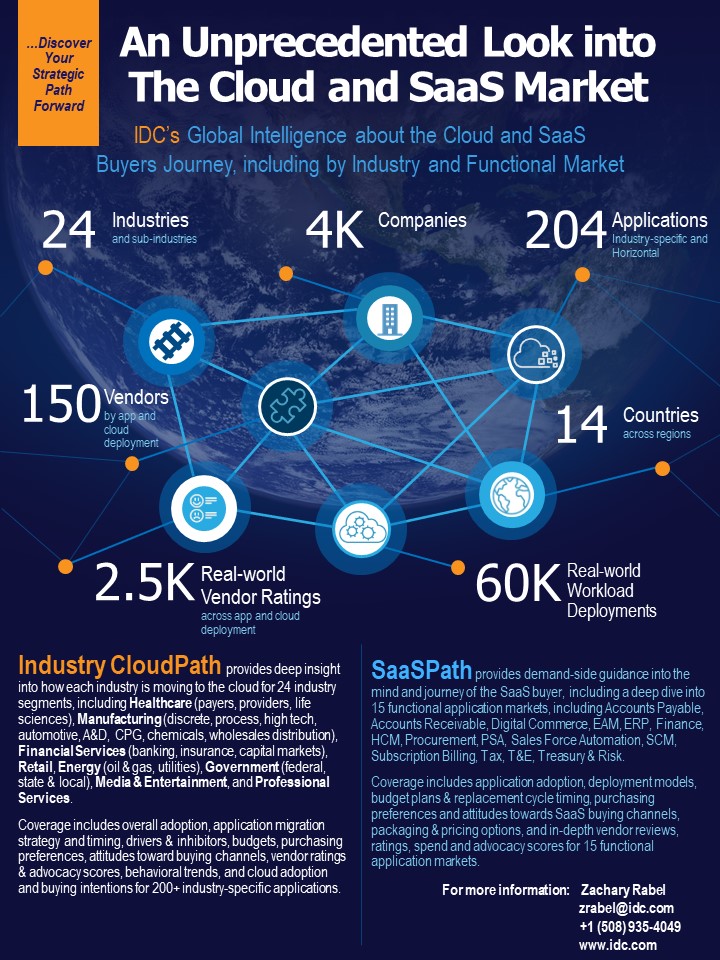Data is the fuel for modernizing and transforming business. While there is no shortage of data – IDC expects data to reach 175 Zettabytes by 2025 – insightful, relevant data is in much shorter supply. I experience this daily in the cloud-related inquiries I receive. In addition to generating timely and relevant insights from data, my role is also to make the data actionable for customers. This means providing the data in a more consumable format and context based on a deeper understanding of what the client needs.
Industry CloudPath and SaaSPath annual benchmark surveys were designed in response to client demand for actionable data on SaaS and cloud buyer adoption and trends across industries, regions, and enterprise business application categories. The survey reaches a total of 180,000 participants who are rigorously screened for participation. The result is a sample of 2000 highly qualified IT and lines of business buyers representing 5 regions and up to 16 countries, 24 industries plus sub-markets, 12 company sizes, and 15 enterprise application categories. Industry CloudPath also tracks current and planned deployments for more than 200 industry-specific application workloads.

Here are just two of the elements our Industry CloudPath and SaaSPath benchmark surveys explore:
Buyer Behavior
Many factors impact buyer behavior. From new and innovative technologies, software delivery models, and new entrants, to generational changes in leadership, the technology buying decision is more dynamic and complex, involving stakeholders from across the organization. It’s the reason why Industry CloudPath is designed to track changes in buyer behavior, and the cloud buyer’s journey from awareness and evaluation to value creation. The results highlight an increase in budget allocation across cloud segments – IaaS – PaaS – SaaS – of 33% for 2019.
Both SaaSPath and Industry CloudPath help inform the global strategies of cloud service providers and SaaS companies, providing contextual insight into buyer behavior. Iran Hutchinson, Product Management Director, Big Data, InterSystems shared his experience with Industry CloudPath –
“We have very quickly received tremendous value from this research, and its value goes well beyond any other data we’ve seen available in the market. We are using it to shape the future direction of our product strategy.”
Cloud Adoption
Results from Industry CloudPath in the adoption of both private and public cloud will be strong for the foreseeable future. Nearly three quarters of the 1,940 participants surveyed currently use or plan to use managed private and public cloud (IaaS). The data reflect the continued strength of a hybrid model across regions and industries. We know for example that buyers in financial services and manufacturing see themselves as more innovative, generally, meaning first to adopt and early adopters of new technology – 33% compared to 26% overall.
SaaSPath reveals that there are measurable gaps between what buyers consider the most important supplier attributes – robust data security, value for price, and ease of use – and what buyers experience. This is critical information for planning a customer retention strategy. Retention and expansion drives SaaS success. Buyers prioritize ease and speed of deployment, guaranteed service levels, and improved features when deciding on increased SaaS provider investment.
Industry CloudPath tracks cloud maturity across five stages from ad-hoc to optimized, and the increased benefits accruing to businesses that have an optimized cloud strategy. Between 2017 and 2019, the percentage of mature cloud companies doubled from 8% to 16%, with Media & Entertainment and Life Sciences having the largest percentage. Cloud providers can increase customer retention and improve business value and TCO by helping customers advanced from early stages of maturity to the more mature managed and optimized stages.
Insight into current and planned deployment for more than 200 application workloads by industry and type (back, front, and middle office) help to inform product development strategies and resource allocation. For example, Industry CloudPath data reveal that nearly three quarters of participating financial services buyers run mission and business critical core banking workloads in the cloud.
Learn more about the results from our latest Industry Cloudpath and SaaSPath surveys:




